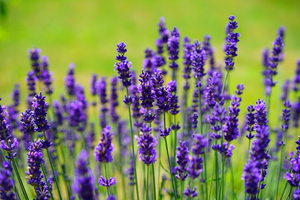Co-herbs
Hormones work better when there is antagonism or a combination of desired hormone effects on a receptor. When there is a lack of antagonism, desensitization is a problem, and effects can quickly cause the opposite of the intended effect. Receptor subtype matters for hormone response. Because of this, phytochemical selectivity of a hormone analog can have different effects. Antagonisms that work on the same receptor type or in the presence of normal body hormones usually produce a synergistic response.
Hops often requies mint. In theory, milk thistle (Silybum) might be a good co-herb for hops. Clover often requires fenugreek. Hops, however, does not work consistently with fenugreek. Evening primrose requires fennel and sunflower. Lavender was removed as a potential co-herb. The efficacy of herb combinations also often depends on phase and part of a phase. There are times when some of the above herbs can be used alone, but it has often been difficult to time their use.
Lactones
Enterolactone, spirolactone and zearalenone (ZEN) belong to a class of lactones. ZEN is a mycotoxin and hormone produced by fungi that can reduce fertility, from negative effects on the ovaries, similar to "clover disease". Enterolactone is metabolized from lignans contained from sunflower and flaxseed, and it appears to modulate estrogen from evidence of raising or lowering body temperature, but there was little evidence of sunflower modulating hirsutism symptoms. The effects of enterolactone vary after which herb it was taken after. Spirolactone has a reputation for use for lowering hirsutism and treating PCOS, but it hasn't always worked for everybody. If spirolactone behaves like other lactones, this can offer an explanation of why it sometimes doesn't work.
Enterolignans
Enterolignans are compounds metabolized in the body from lignans. Lignans are insoluble fibers that are not found in plant oils. Sources of lignans include: sunflower, flax, sesame, pumpkin, rye, oats and barley.
While enterolignans and lignans are considered estrogenic, they are not identical in structure to estrogens like many phytoestrogens are. It is possible that enterolignans help regulate estrogen synthesis in the body. The behavior of herbs containing enterolignans seem to have differences than estrogen cream: both seem to have the ability to regulate body temperature, but estrogen cream seems to circumstantially influence body hair. It is not certain if lignans or enterolignans directly bind to estrogen receptors.
Enterolignans include enterodiol and enterolactone, and are formed from lignans such as matairesinol, pinoresinol, secoisolariciresinol and sesamin. Enterolactone is a lactone, rather than an estrogen.
Anon03 Blog of Herb Use
Program blog of herb combination effects for different times of the menstrual cycle.
Co-herbs
Hormones work better when there is antagonism or a combination of desired hormone effects on a receptor. When there is a lack of antagonism, desensitization is a problem, and effects can quickly cause the opposite of the intended effect. Receptor subtype matters for hormone response. Because of this, phytochemical selectivity of a hormone analog can have different effects. Antagonisms that work on the same receptor type or in the presence of normal body hormones usually produce a synergistic response.
Hops often requies mint. Clover and lavender often requires fenugreek. Hops, however, does not work consistently with fenugreek. Fennel requires evening primrose. The efficacy of herb combinations also often depends on phase and part of a phase. There are times when some of the above herbs can be used alone, but it has often been difficult to time their use.
Treating Hirsutism Blog Updates
Program blog about an attempt to treat female body hair and female hair loss, and to promote breast enlargement despite it.
Updated.
Estrogen Deficiency
Basic symptoms of estrogen deficiency. Old articles on aromatase and anti-dht herbs redirect here.
Humulus update, and Black cohosh
Hops (Humulus) and black cohosh work on ER-alpha to lower LH levels. These two herbs share similiar actions on the pituitary.
Hops is a safer herb to use. Thistle may possibly have the same mechanisms as hops and black cohosh, but there lacks studies to be certain.
Evening primrose
Profile of evening primrose (Oenothera). Correction: evening primrose contains alprostadil, not dinoprostone, which also likely raises FSH.

Photo update for anon02
Image [on far right] taken on August 15, 2018.
Receptor Regulation
Herbs that sensitize estrogen, androgen and progesterone receptors cause different effects depending on the presence of bodily hormones or other herbs. Herbs that upregulate estrogen receptors include: hops, ginseng, lavender and schizandra. Thistle and clover probably upregulate estrogen receptors too. The best time to take these herbs is during mid-secretory phase and early premenstrual phase, after testing if evening primrose oil causes growth. Prolactin increasing herbs like clover, thistle and hops can't be taken during proliferative phase. Lavender and ginseng can be taken during mid-proliferative phase, only if primrose works first for that day.
Q&A: butt enhancement update
Update on herbal butt enhancement.
Treating Hirsutism Blog
Program blog about an attempt to treat female body hair and female hair loss, and to promote breast enlargement in spite of it.
Celery family
The celery family includes several herbs with hormonal properties: angelica (dong quai), anise, caraway, carrots, celery, coriander, cumin, dill, fennel, parsley. These herbs have varying hormonal properties: few are estrogenic. Dill increases the production of progesterone.
Unfortunately, the celery family has a few toxic members that can cause severe permanent injury to the touch and death: hemlock, fool's parsley and hog weed. These deadly plants resemble other members within the celery family.
Be sure you properly identify safe herbs before handling or use.
Hot-flashes
Low estrogen contributes to hot-flashes in women. Hot-flashes are common when luteinizing hormone (LH) is high.
Evening primrose (Oenothera biennis) oil [conditionally] increases estrogen production and has been proven in studies to lower hot-flashes. Oenothera biennis is useful during proliferative phase to increase estrogen for breast enhancement.
Herb quality
Some herb supplements use fillers or have traces of other herbs in them. This happens when machines are used for different herb formulas. It is especially a problem when cross contamination occurs from using the same machines to manufacture individual herbs and women's formulas as male formulas. Buy reputible brand herbs or identify whole herbs with certainty to avoid this. Test a fraction of bottled supplements individually, and wait the next day to check for unwanted effects that are uncharacteristic of the intended herb.
Panax ginseng and related herbs
Panax ginseng upregulates androgen receptors and estrogen receptors α and β.
Not all herbs that improve symptoms of hot-flashes increase estrogen synthesis, or address the root problem. Common sage (Salvia officinalis) is useful for hot-flashes, but it is not suitable to replace red sage to upregulate estrogen receptors. In large amounts, Salvia officinalis diminishes the ovaries, possibly because of apigenin.
Gardenia
Gardenia oil increases estradiol, and decreases LH and FSH [perhaps depending on menstrual phase].
Theory on herbs that regulate ovarian health during different phases
Estrogenic herbs such as ginseng, fennel, schizandra and sage regulate ovarian size and function. My theory is that whether estrogenic [upregulating] herbs diminish or nourish the ovaries depends on whether they are taken during the proliferative and ovulation phases, and in the presence of other present hormones.
Estrogen is naturally the dominant hormone during proliferative phase. When breast growth is caused primarily by progesterone, that is not representative of ovarian growth. The sensitization and function of androgen receptors (AR), estrogen receptors (ER) and aromatase enzymes in the ovaries are equally important for health. When there is a lack of stimulus of androgen or estrogen effects, the ovaries shrink. When either progesterone, androgen or estrogen effects are primarily present, ovarian function diminishes. Estrogen production relies on the presence of androgens, and likewise, when both estrogenic and androgenic circumstances are present, the ovaries perform functionally.
During mid- proliferative phase and ovulation phase, ginseng, fennel and lavender by themselves cause breast growth, which may be a representation of ovarian growth. During other phases, ginseng and fennel taken by themselves cause breast shrinking, which may be associated with ovarian shrinking. Lavender taken outside of proliferative phase requires the use of mint, fenugreek or another androgenic herb for breast growth.
Studies on different species of sage (Salvia) manifest different results of diminishing or improving function of the ovaries. This could be perhaps, because of variations of phytohormones present in different species of sage or by methods of extract. Studies show that fennel, schizandra and ginseng improve ovarian function, but this may be circumstantial, based on the phase of the menstrual cycle and in the presence of other bodily hormones.
Celery family
The celery family includes several herbs with hormonal properties: dong quai, fennel, dill, carrots, celery, parsley. Several of these herbs are estrogenic.
Unfortunately, the celery family has a few toxic members that can cause severe permanent injury to the touch and death: hemlock and hog weed. These deadly plants resemble other members within the celery family.
Be sure you properly identify safe herbs before handling or use.
Humulus; Hops profile
Hops (Humulus) upregulates estrogen receptor alpha (ERα). It also increases prolactin levels.
Q&A: update
Butt enhancement.
Receptor subtypes
Progesterone has 4 isoforms in humans. We are most familiar with PRA and PRB. Less is known about PRC and PRD. Estrogen has 2 isoforms, ERα and ERβ. Androgen has 1 isoform, AR. All receptors are important, even if we haven't identified their full properties.
Q&A: updates
Animal ovary; Breast enhancement in 40's; Update on DHT lowering herbs.
Panax ginseng and Schizandra chinensis
Panax ginseng and Schizandra chinensis upregulate estrogen receptors and increase bodily estrogen. Panax ginseng also lowers LH and FSH, while increasing ovarian weight in animal studies. There was not enough available information on other Panax species.
The recommendation of Panax ginseng or Schizandra chinensis is a peasized amount as tea during proliferative phase, and when androgen symptoms are high. If effects don't improve, then stop immediately.
Diosgenin
Diosgenin increases bodily estradiol, and it may also be helpful against insulin resistance. Diosgenin is a phytohormone contained in wild yam (Dioscorea). Fenugreek (Trigonella) also contains diosgenin, but it also has other phytochemicals with varying properties.
Androgen excess and hot flashes: correction on DHT's ability to modulate aromatase
Temperature increase and hot-flashes are an indirect result of low estrogens. Androgen symptoms can be high, which signifies low estrogen levels, yet there can still be symptoms of hot-flashes.
Herbs that antagonize estrogen receptors usually resensitize those receptors in small amounts, but in large amounts will desensitize them.
DHT
It is important that estrogen receptors and aromatase enzymes are kept sensitive and healthy. DHT desensitizes many hormonal receptors, possibly including estrogen receptors. Surprisingly, androgens including DHT upregulate aromatase enzymes in mammals (unlike in birds and in fish).
DHT reducing herbs are thought to be useful for lowering signs of androgens. Herbs with DHT reducing properties that also increase LH eventually increase androgens and subsequently DHT. Mints, Saw Palmetto and Reishi may temporarily reduce androgen symptoms, but continued use will make them worse. Reishi has a reputation for causing hot-flashes.
Equol is a phytochemical that attaches to and neutralizes the hormone 5⍺-DHT, and it has successfully reduced DHT symptoms in animal studies. Unfortunately, large amounts of equol reduce aromatase capacity, while small amounts have little effect on aromatase capacity.
Lavender [in small amounts] is a suitable herb for lowering DHT, because it does not increase LH.
DHT is said to not be capable of being aromatized, but it can be converted into βdiol, an androgen with estrogenic properties.
Prolactin
Prolactin does lower androgens, but during secretory phase, it increases progesterone, which a higher relation of progesterone to estrogen is responsible for hot flashes or high body temperature.
Prolactin raising herbs should be used outside of secretory phase for lowering androgens. During secretory phase, the use of prolactin raising herbs should be used cautiously and in minimal amounts, with herbs that increase estrogenic responses.
Aromatase modulation
Aromatase is the bodily process of converting androgens, with the exception of dihydrotestosterone (DHT), into estrogens. Enzymes for aromatase modulation occur in tissue near estrogen receptors.
The capability for aromatase in granulosa cells within the ovaries is important for reproductive health, despite that plenty of other tissue than can perform this function. The maintenance of aromatase sensitization in granulosa tissue is imperative.
Plenty of herbs and their components modulate aromatase enzymes. There are a few herbs, that in small doses sensitize aromatase capabilities, but in large doses decrease aromatase capability. Mints, clover and other herbs should be taken in the lowest amounts possible, because in large amounts they may desensitize. The use of mint and clover should be below 100mg, and perhaps in tea form. Flaxseed (due to their lignan content) and pueraria (of the legume family) use should also not be overdone. Mint, pueraria and clover also work strongly on reproductive tract tissue.
For reference: an average small metal paperclip weighs upward of approximately 500mg. The importance of aromatase modulation in granulosa tissue will be reflected in the ebooks breast-endocrinology and super-bazongas. For any herb schedule, reduce the amounts of mint, clover, pueraria and flax. In the latest ebook, clover and mint amounts are already lowered, but they will be lowered more to reflect this update.
Aromatase
Aromatase is the bodily process of converting androgens, with the exception of dihydrotestosterone (DHT), into estrogens. It so happens that aromatase enzymes occur in tissue where...
Mint
Hormonal properties of mint and its use for breast enhancement. The genus of mint goes by the scientific name of Mentha.
Mint is often suggested to have estrogenic properties, however, it appears to have androgenic attributes...
Vitex
Hormonal properties of Chasteberry. It is used to lessen breast discomfort, to lessen premenstrual symptoms and to lower prolactin.
Pharmaceutical profiteering
Article from Bloomberg about hospitals' interests in entering the generic pharmaceutical market to provide reasonable generic drug prices to patients.

Lavender
Lavender's estrogenic properties for breast enhancement.
Menstrual phases
The menstrual cycle will be divided into 5 phases, to simplify their timing: Menstruation, Proliferative, Ovulation, Secretory and Premenstrual.
Follicular phase is divided between menstruation and proliferative phase. Menstruation is when the uterus lining is shed. The proliferative phase is from the end of menstruation until ovulation. This is the time when the uterus rebuilds to prepare for potential pregnancy.
Luteal phase has been divided into secretory and premenstrual phase. The secretory phase is when the corpus luteum is present and produces progesterone. Premenstrual phase begins when the corpus luteum disintegrates, and it ends at the beginning of menstruation.
For more about determining menstrual phase, read Menstrual Phases.

Herbal Breast Enhancement: 3 months
Herbal breast enhancement pictures [3 photos on the left] each month from October until December 2017. [Plus an additional photo from August 2018 on far right.]

Post your results
If you've had success with the information from super-bazongas.pdf, and want to display your results, you can do so securely here.
You must be over 18 years old to post pictures. The pictures will belong to you, but once they are posted on the Internet, distribution of them is out of control. I can remove them if you choose, but please leave an alternate picture of results, even if covered.
You can black and white, or censor the pictures, if you choose. In general, for any website, don't send pictures of your face or identifying background objects, even in different pictures, unless you don't mind being known for them. Also, remove metadata (such as gps location) that sometimes gets added to your pictures by your camera.
When resizing images, resize the width or height of an image at a time, or the image will stretch.



